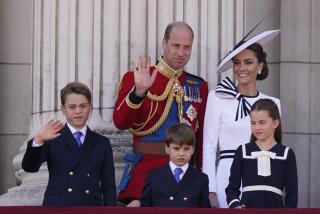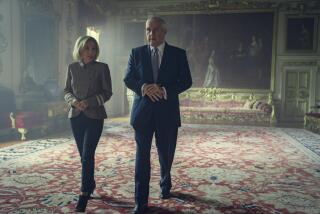Andrew, Sarah Married Amid Royal Splendor
- Share via
LONDON — Red-haired, freckle-faced Sarah Ferguson on Wednesday married Queen Elizabeth’s second son, Andrew, at stately Westminster Abbey amid fanfares, pealing bells and cheers from an estimated 500,000 well-wishers in London’s streets.
With a global television audience estimated at more than 300 million looking on, the Royal Family celebrated the occasion with a sense of pomp, military precision and style that have become a British trademark. Not even the bride, clad in a flowing, Edwardian-style gown with an elaborately embroidered and beaded train, was late for the ceremony.
The bride and groom, both 26, entered Westminster Abbey as Andrew, the royal playboy, and Sarah, the commoner daughter of a British military officer, and emerged as the Duke and Duchess of York.
Queen Elizabeth had officially dubbed Andrew the Duke of York--a title often bestowed on the second sons of monarchs--as a wedding gift 90 minutes before the ceremony. Andrew also automatically received a raise in salary upon saying his vows, from $30,000 a year to $75,000.
After the church service, presided over by the Archbishop of Canterbury, Robert A. K. Runcie, the couple crowned the day for thousands of spectators by appearing on the balcony of Buckingham Palace with the queen, the Prince and Princess of Wales and the rest of the Royal Family. With members of the crowd prompting, “Kiss, kiss,” the two exchanged a soft kiss on the lips.
The ceremony was less elaborate than the 1981 wedding of Prince Charles and then Lady Diana Spencer, and the day was not proclaimed a public holiday. Nonetheless, thousands of Britons abandoned their work stations to watch the Royal Family travel, in gilded carriages and coaches, to the 11th-Century abbey.
The 1,700 guests inside the abbey included princes from Europe and Japan, American First Lady Nancy Reagan, a sprinkling of show business celebrities, and, at Sarah’s insistence, friends from her home village, Dummer, 49 miles west of London, as well as all the men and women who arranged the 30,000 flowers massed all over the abbey.
Fashion experts who had criticized the latest Royal Family member’s figure and supposed lack of clothes sense, and openly fretted about her choice of an unknown designer for her wedding gow1848385641proclaimed her ivory-colored, silk dress a triumph.
The gown, by 34-year-old London designer Lindka Cierach, was beaded with the bees and thistles of the bride’s coat of arms. Anchors and waves, to honor her new husband, an officer in the Royal Navy, were embroidered on the 17 1/2-foot train, centered with his monogram, a large A. Four S’s, for Sarah, were outlined in beads on the pearl-edged bodice.
After the wedding, a midday breakfast of roast lamb and lobster and an extended reception, the royal couple left the palace in an open, horse-drawn coach for the airport and a honeymoon flight to Portugal’s Azore Islands, 740 miles west of Lisbon.
Prince Edward, Andrew’s younger brother and “supporter” or best man, loaded their going-away coach with a huge brown teddy bear, attached a fake satellite dish with the message “phone home” to the vehicle’s rear and festooned it with flags and balloons. At Heathrow Airport, the Royal Air Force jet taking the couple on their honeymoon revealed a large “Just Married” sign near its tail as it taxied for takeoff.
On a day of royal solemnity, punctuated by a light-hearted spontaneity, the bride’s only flicker of nerves came during the exchange of vows. Although she said she had practiced for hours, she stumbled over Andrew’s four names, Andrew Albert Christian Edward, reciting Christian twice.
The mistake was similar to that made by Princess of Wales, who flubbed the names of Prince Charles at their wedding.
But for the most part, the bride was true to her prediction that she would not let the grandeur of the event prevent her from enjoying what she referred to as “the best day of my life.”
Some spectators said they saw her wink at Andrew beneath her veil as she vowed to “obey” her husband. Her choice of the traditional wording, instead of a more modern version that replaces “obey” with “cherish,” generated a flurry of protest from feminists. In interviews, however, she has insisted that she was not one to “meekly follow behind” her husband on all occasions but said she believes the husband should lead the family.
Moments after exchanging vows, she and Andrew grinned and whispered to each other. As she walked back down the blue-carpeted aisle, she acknowledged several friends and then later, from the balcony of Buckingham Palace, teased the huge crowd gathered outside, pretending she couldn’t hear their chanted demand for the couple to kiss.
Her upbeat mood, also apparent in an hourlong nationally televised interview aired Tuesday evening, percolated through the large crowds that lined the procession route from Buckingham Palace to the abbey and helped turn the event into a carnival-like, nationalistic celebration.
Although the wedding was filled with pomp, the absence of a state occasion gave it an informality lacking at the 1981 royal wedding.
In the industrial north of England, factories halted production as workers watched the wedding on large-screen televisions. In the southwest county of Devon, villagers held street parties, while travelers on British Railways’ long-distance trains were presented with champagne breakfasts.
In much of Cornwall, milk was delivered Wednesday with tops declaring, “To Sarah and Andrew, Congratulations.”
Said 18-year-old David Hogg, who traveled 110 miles and spent the night on the sidewalk of Parliament Square to ensure a good view of the processions, “It all makes me feel very, very British indeed.”
A visible cross-section of a society noted for its class divisions gathered on the streets with the common purpose to cheer and wave small Union Jacks at virtually every moving vehicle that passed in the hours before the official wedding procession began.
A large yellow banner with the word “Congratulations” hung from a building across Victoria Street from the abbey, while a blimp circled over the city with the words, “Good Luck.”
“It’s a day we can forget our troubles and get together,” said Peter Moore, London’s official town crier, decked out in his traditional 18th-Century red coat, black pants and white knee-length stockings for the event.
But a global interest was also apparent. Across from the abbey, Australia’s main commercial television network had set up its studio in an open-top, double-decker London bus, while four American networks, based elsewhere in the city, gave the event saturation coverage.
The estimates of television audience ran between 300 million and 500 million, as 32 countries received live broadcasts.
The procession began, as scheduled, at 10:57 a.m., with the queen and her 24-horse escort winding their way from the palace to the abbey. It ended with the arrival of the bride. After watching the bride’s horse-drawn, glass coach halt at the abbey’s west entrance at exactly 11:30 a.m., the crowd along the streets followed a radio commentary of the ceremony inside.
As Andrew uttered his clear “I will,” the reverent silence inside the church, the scene of royal weddings, funerals and coronations for 900 years, suddenly filled with the sounds of wild cheering from the crowd outside, giving its own, less inhibited response to his words. Moments later, the cheers came again, this time even louder, as the bride said her “I will.”
There were similar cheers after the congregation sang the national anthem, “God Save The Queen.”
The presence of four bridesmaids and four pages dressed in sailor suits, the oldest of whom was 8, also lightened the atmosphere.
Seven-year-old Lady Rosanagh Innes-Ker was at one point so busy straightening the bride’s train for the exit procession that she yanked the bride’s head back.
Charles and Diana’s elder son, 4-year-old Prince William, who has already gained a certain notoriety for unpredictable behavior, couldn’t resist pulling strange faces at one point during the service. He also played with the blunt-ended toy knife that was part of his costume, wound the strap from his hat around his neck and stuck out his tongue at a bridesmaid, his cousin, Laura Fellowes, 6.
The royal guests, seated just in front of the bridal pair, included the queen, the Duke of Edinburgh, Princess Diana, Prince Charles and Princess Anne and her husband, Army Captain Mark Phillips, and Elizabeth, the Queen Mother.
Ambassadors from many nations attended, and others guests included singer Elton John, in a pigtail and pink-framed eyeglasses, actor Michael Caine and well-known Britain comedian Billy Connolly.
The warmth of the event and the mood of the crowds lining the procession route appeared eventually to buoy the queen, who appeared serious and unsmiling during the wedding ceremony itself. By late afternoon, as the wedding pair were leaving Buckingham Palace for their holiday, the queen was seen laughing, joking and, at one point, running after a loose royal child.
An extremely popular monarch, the queen has been embroiled in an unprecedented political controversy in recent days, with press reports alleging that she is displeased with Prime Minister Margaret Thatcher’s policies on South Africa, particularly her opposition to economic sanctions against South Africa, and fears they might lead to the destruction of the Commonwealth.
At one point in the service, the Archbishop of York, John Stapylton Hapgood, appeared to inject the wedding into that debate with a prayer expressing the hope for a strengthened Commonwealth. Cardinal Basil Hume, the leader of Britain’s Roman Catholics, also participated in the rites.
There were audible snickers when television monitors focused briefly on the prime minister, another guest, who was seemingly stuck behind a pillar. Thatcher was booed by some spectators as she entered the abbey.
The royal pair are expected to live temporarily in Buckingham Palace after returning from their honeymoon, while the newly named duke undergoes additional military training.
He served as a helicopter pilot in combat during the 1982 Falkland Islands War with Argentina and is due shortly for a new assignment. In their pre-wedding interview aired Tuesday evening, the then-Sarah Ferguson declared she wanted to learn to fly in order to better understand her husband’s job.
In the same interview, she also countered critics who complained she had a weight problem and gave her own idea of what constituted a a good figure.
“A woman should have a trim waist, a good ‘up top’ and enough down the bottom, but not too big,” she said.
More to Read
Sign up for Essential California
The most important California stories and recommendations in your inbox every morning.
You may occasionally receive promotional content from the Los Angeles Times.













